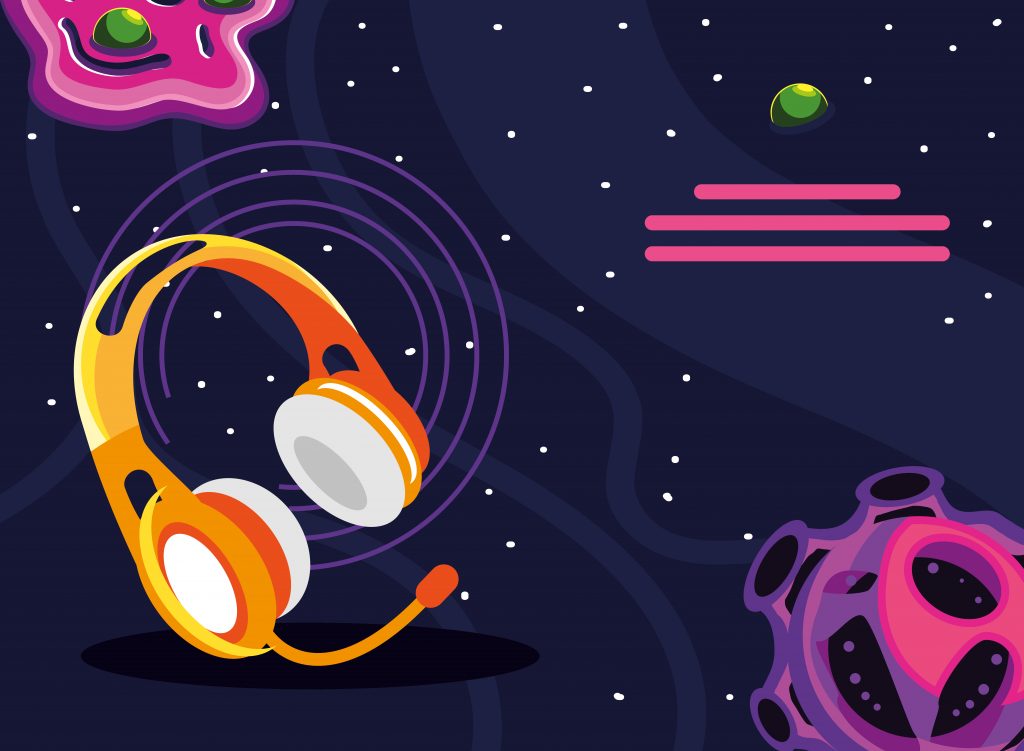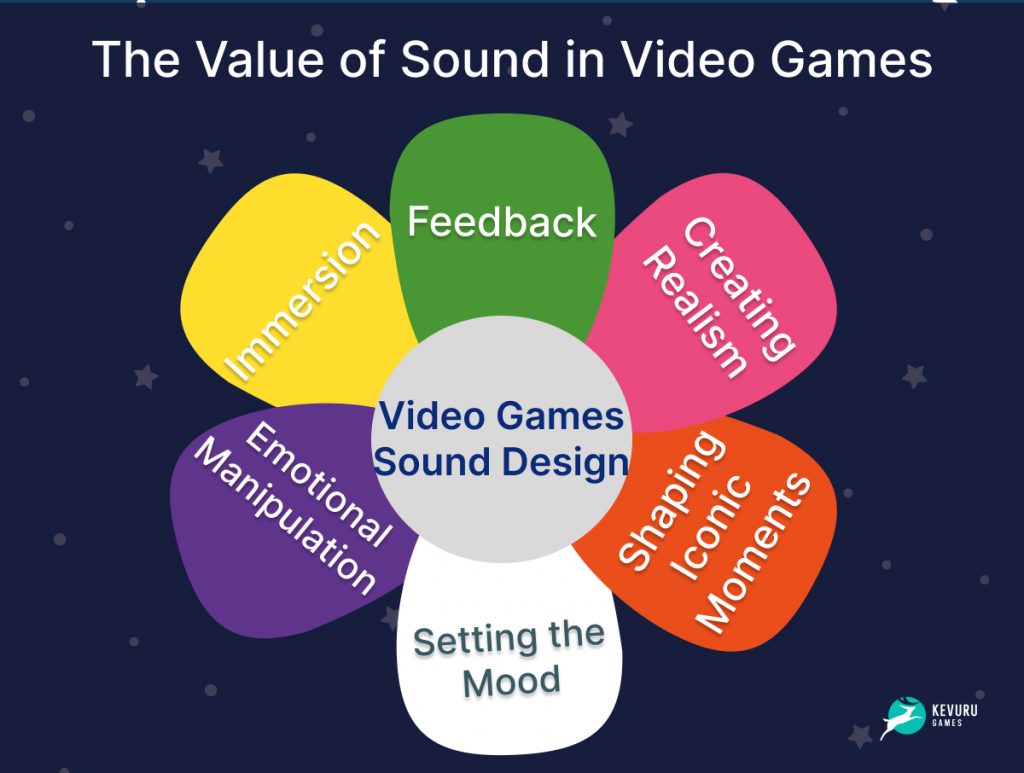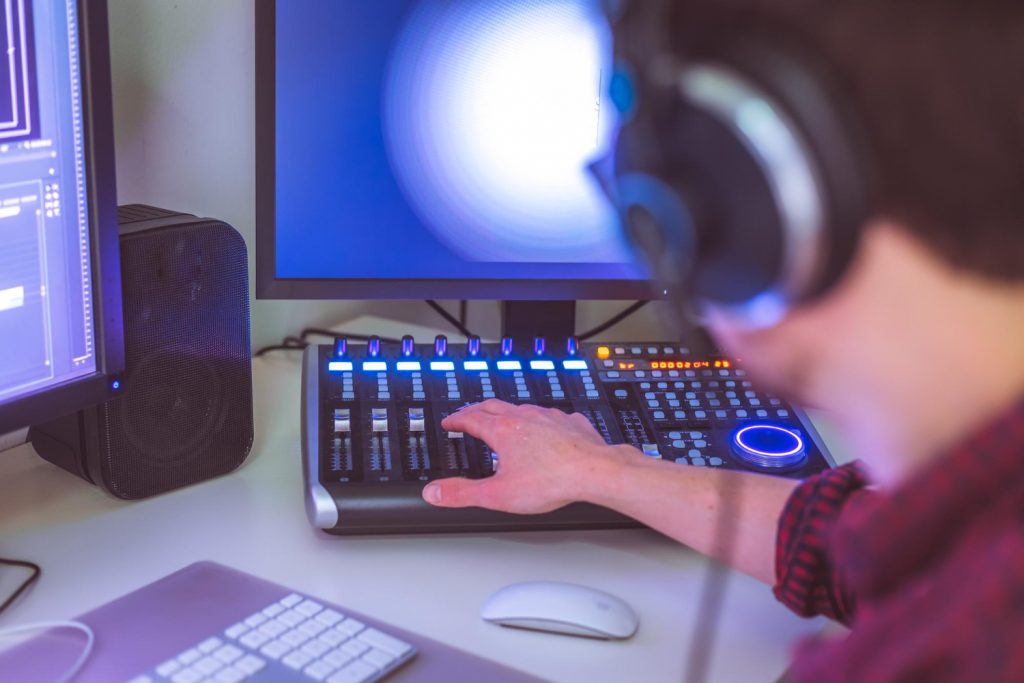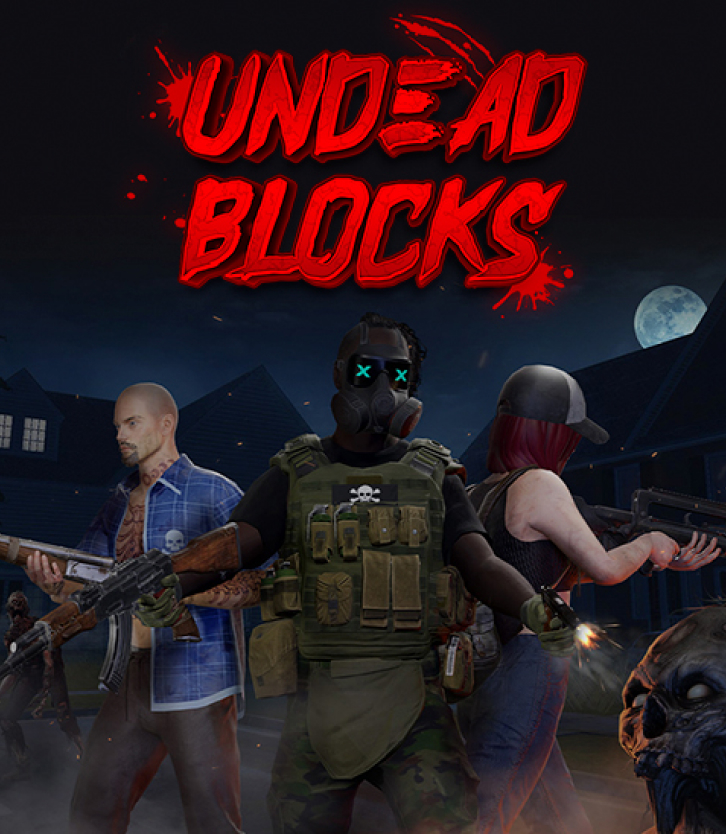Video game sound design encompasses creating and implementing audio elements that bring games to life. It immerses players in rich, dynamic virtual worlds. We offer you the opportunity to delve into video game sound design’s immense potential and impact on player engagement, emotional connection, and overall game success.
Sound designers can build a sonic landscape that complements the game’s visual elements through the careful use of ambient sounds, environmental audio effects, and realistic character interactions. By achieving sonic realism, players feel a deeper connection with the virtual environment, enhancing their overall gaming experience.

What is Video Game Sound Design?
Sound design for video games is about creating and implementing audio elements that bring video games to life. It involves crafting various sounds, from ambient noises and environmental effects to character interactions and music. It also aims to enhance the overall gaming experience by immersing players in a rich and dynamic auditory world.
The sound design in video games goes far beyond simple background music or generic sound effects. It involves carefully selecting and manipulating sounds to create a sense of realism. Designers aim to transport players into the game world, making them feel like active participants in the virtual environment.
One of the fundamental aspects of sound design for video games is creating sonic realism. It involves capturing and replicating real-world sounds or constructing believable sounds that match the game’s context. Whether it’s footsteps echoing in a cavernous dungeon, the rustling of leaves in a virtual forest, the sound of a sword clashing with an enemy’s shield, or the distinct noise of a door, these audio elements contribute to the overall atmosphere and make the game world feel more authentic.
Music also plays a crucial role in video game sound design. A well-crafted musical score can evoke emotions, enhance storytelling, and heighten the gaming experience. From epic orchestral compositions to ambient melodies, the choice of music sets the tone for different gameplay moments, intensifying action sequences and creating a sense of tranquility during exploration.
The value of sound in video games
Sound is an invaluable element in video games, offering a range of benefits that greatly enhance the gaming experience. From immersion and feedback to emotional manipulation and setting the mood, it plays a pivotal role in shaping unforgettable gaming moments.
1. Immersion: It’s instrumental in creating a truly immersive gaming experience. Designers transport players into rich and dynamic virtual worlds by carefully crafting ambient sounds, environmental effects, and character interactions. The sound of rain pouring, birds chirping, or footsteps echoing in a deserted hallway all contribute to the sense of being present in the game’s environment. The immersive sound design allows players to suspend disbelief and be fully engrossed in the virtual realm;
2. Feedback: It serves as a vital tool for providing feedback to players. Whether it’s the satisfying “ping” of a successful attack or the ominous growl of an approaching enemy, sound effects reinforce actions and help players understand the consequences of their choices. Timely and well-designed auditory cues enhance the player’s sense of agency, making gameplay more engaging and rewarding;
3. Emotional Manipulation: Music can remarkably evoke emotions and manipulate the player’s feelings. A well-composed musical score can enhance the narrative, heighten tension during intense moments, or produce a sense of nostalgia. By leveraging the power of music, video game sound designers can create emotional depth, enriching the player’s connection to the game’s story and characters;
4. Setting the Mood: It plays a crucial role in setting the mood of a video game. From eerie and suspenseful soundscapes in horror games to upbeat and energetic tracks in action-packed adventures, sound helps establish the desired atmosphere. By carefully selecting the right combination of sounds and music, game developers can immerse players in a specific mood, enhancing their overall gaming experience;
5. Creating Realism: Realism is a key aspect of many video games, and sound design plays a significant role in achieving it. Designers add layers of authenticity to the game’s audio landscape by capturing and replicating real-world sounds or constructing believable alternatives. Realistic sound effects, such as the revving of an engine or the sound of footsteps on different surfaces, contribute to the player’s sense of immersion and make the game world more tangible;
6. Shaping Iconic Moments: Certain moments in video games become iconic, etching themselves into players’ memories. It often plays a pivotal role in these standout moments. Whether it’s a dramatic orchestral score during a climactic boss battle or a catchy theme song that instantly brings to mind a beloved game franchise, the sound design creates audio signatures that become intertwined with the player’s gaming experience. These iconic sound moments leave a lasting impression and contribute to the game’s legacy.

The Constraints of Video Game Sound Design: Exploring the Non-Linearity, Unpredictability, and Repetition Challenges
From immersive environments to dramatic gameplay moments, sound has the power to captivate players and bring virtual worlds to life. However, the art of video game sound design comes with its own constraints and challenges that developers must navigate.
The Non-Linearity of Sound
In video games, the sound is not limited to a linear progression like in movies or music. Unlike other media forms, video games offer a dynamic and interactive experience where the player’s actions can alter the course of the game. This non-linearity poses unique challenges for sound designers. They must anticipate and accommodate different player choices, ensuring the audio seamlessly adapts to the changing game states.
When designing non-linear sound, one must consider various factors such as player movement, object interactions, and environmental changes. For example, in an open-world game, the sound design should adapt based on the player’s location, time of day, and weather conditions. The soundscapes must evolve organically, creating a sense of realism and immersion for the players.
The Unpredictability of Sound Mixing
The unpredictable nature of sound mixing is another limitation that faces video game sound designers. Unlike film or music production, where every element is meticulously timed and synchronized, video game sound mixing is subject to dynamic events that occur in real-time. Game audio needs to respond to player actions, and this can make the mixing process complex and challenging.
Designers often employ adaptive audio techniques to achieve optimal sound mixing in video games. These techniques involve using algorithms and triggers to seamlessly blend and transition between different audio elements. By dynamically adjusting volume, pitch, and effects, sound designers can create immersive audio experiences that react to in-game events, maintaining a cohesive and engaging soundscape throughout the gameplay.
Repetition
Repetition is both a powerful tool and a challenge in video game sound design. On the one hand, repetition can reinforce important gameplay elements and create familiarity for the players. Recognizable sound cues for actions like collecting items or defeating enemies can enhance the player’s sense of achievement and progress. On the other hand, excessive repetition can quickly become tiresome and diminish the overall experience.
To strike a balance, designers must carefully consider the frequency and context of repetitive sounds. Implementing variations, subtle nuances, and context-specific audio cues can help prevent monotony and keep players engaged. Additionally, interactive sound systems that respond to player input can introduce dynamic audio elements, reducing the feeling of repetitive loops and adding depth to the game’s sonic landscape.
Remember, sound design for video games is a multifaceted discipline that continues to evolve alongside technological advancements and artistic innovations.
Is Proficient Sound Design Important?
Proficient sound design is of utmost importance in various fields and industries. Whether it’s film, television, video games, music production, or even virtual reality experiences, sound design plays a crucial role in improving the overall quality and impact of the final product. It’s an element that can greatly influence audience emotion, immersion, and engagement.
Skilled sound design involves the clever manipulation and arrangement of audio elements such as dialogue, music, sound effects, and ambient sounds. It goes beyond simply recording and mixing audio data to encompass the creative process of designing and shaping sound to create a coherent and immersive audio experience.
In film and television, skillful sound design brings images to life, enriches the narrative, and helps convey emotion and mood. It adds depth, realism, and authenticity to what happens on screen, making for a compelling and memorable viewing experience.
Professional sound design is critical to creating engaging and interactive environments in video games. It helps players navigate and interact with the game world by providing auditory cues and feedback. Whether it’s footsteps echoing in a cave, the revving engine of a sports car, or the musical score. The sound design in games contributes to the overall atmosphere and immersion.
In virtual reality experiences, professional sound design is essential to create a sense of presence and spatial awareness. By accurately reproducing directional cues, designers can immerse users in a virtual environment and make them feel truly present in the virtual world.
By harnessing the power of sound, experienced sound designers can captivate audiences, evoke emotion, and leave a lasting impression on listeners or viewers.

Kevuru Games Expertise in Video Game Sound Design
Kevuru Games has worked in the game market for 11 years, and we position ourselves as professionals in game development. Our video game sound designers have expertise in delivering top-notch sound design solutions that elevate the gaming experience to new heights.
One of the core strengths of the Kevuru Games team is its deep understanding of the unique requirements and challenges of video game sound design. It’s vital working with sound as an integral part of the interactive medium.
So we approach each project holistically, considering gameplay mechanics, narrative elements, and player immersion to design soundscapes that transport players into the virtual worlds they explore.
Our sound designers always work closely with game developers to seamlessly integrate sounds into the game engine, ensuring optimal performance and a cohesive audio experience across different platforms and devices. We also prioritize communication with clients, actively involving them in the creative process to ensure that the final sound design aligns with their vision. Whether it’s a small indie project or a large-scale AAA game, Kevuru Games has the knowledge and skills to bring the sonic dimension of any game to life.
Conclusion: How to unlock the Full Potential of Video Game Sound Design
The role of sound in video games goes beyond background music and generic sound effects. It’s about creating realistic and authentic sounds that fit the context of the game, whether it’s the rustling of leaves in a virtual forest or the distinct sound of a door opening. These sound elements contribute to the overall atmosphere and make the game world seem more tangible.
The sound design provides some benefits that greatly enhance the gameplay experience. It creates immersion by placing players in rich and dynamic virtual worlds. It provides feedback, reinforces actions, and enhances the player’s sense of agency. It manipulates emotions, increases tension, and creates a sense of nostalgia. It sets the mood by developing the desired atmosphere for different game moments. It adds to the realism and makes the game world feel more authentic. And it shapes iconic moments that are interwoven with the gaming experience.
When you work with Kevuru Games, you can expect seamless integration of sounds into the game engine, optimal performance on different platforms and devices, and active participation in the creative process.
Unlock the full potential of video game sound design with Kevuru Games. Contact us today to discuss your project and let our expertise help you create a memorable gaming experience.










![Indie Game Development: Guide to Revenues, Most Profitable Genres & Monetization [+10 Best Indie Games 2024]](https://kevurugames.com/wp-content/uploads/fly-images/11949/indie-pre-138x138.jpg)
